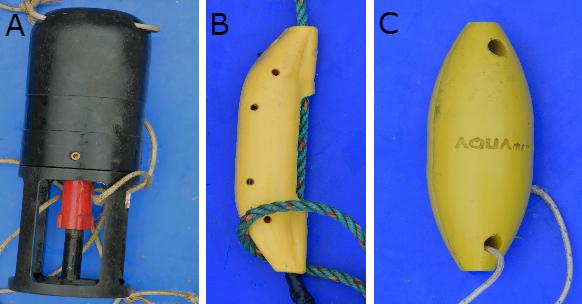Methods
The dinner-bell effect and fish preference tests on grey seals

Twenty buoy setups were deployed in a semi-random grid in the mouth of Bråviken, the archipelago South/South-East of Näverkvarn on the East coast of Sweden. The buoy setups were equipped with a test rig consisting of a wooden pole with a phone, fishes, a thermometer, a pinger and, on five of the rigs, a camera connected to it. The phone could move in two directions: tipping to the side or nodding forward. This movement depended on wich of the two fishes were taken by the seal. I went out to the buoys almost every day to change pingers and fish and to change batteries and memorycards of the cameras.
The idea was that the phone would be logging its movement via a custom-made app. That way I would know when a fish was taken and also which fish was taken first.
The pingers used were the Aquatec 2446 experimental "Seal-safe" pinger (A in the picture below), the Banana pinger (B) and the AquaMark100 pinger (C). The first two were considered inaudible for seals and was used in the dinner-bell effect test while the latter was considered audible for seals and was used for the fish preference test. The "Seal-safe" pinger emits pings between 50 to 150 kHz, the Banana pinger 50-120 kHz and the AquaMark100 pinger 20-160 kHz with a source level of 145 dB re. 1 µPa at 1 m.
In the dinner-bell effect test the pingers were randomized and also controls were tested with no pinger. In total I deployed 54 Seal-safe pingers, 117 Banana pingers and 194 controls.
For the dinner-bell effect test herring was used as bait. For the fish preference test herring, perch, flatfish, whitefish and salmon were tested in randomized pairs. In total 53 such pairs were tested.
Unfortunately the phones did not work as planned so instead of time when a fish was taken I used taken or not taken as the dependent variable.

Responsible for this page:
Director of undergraduate studies Biology
Last updated:
06/04/18
